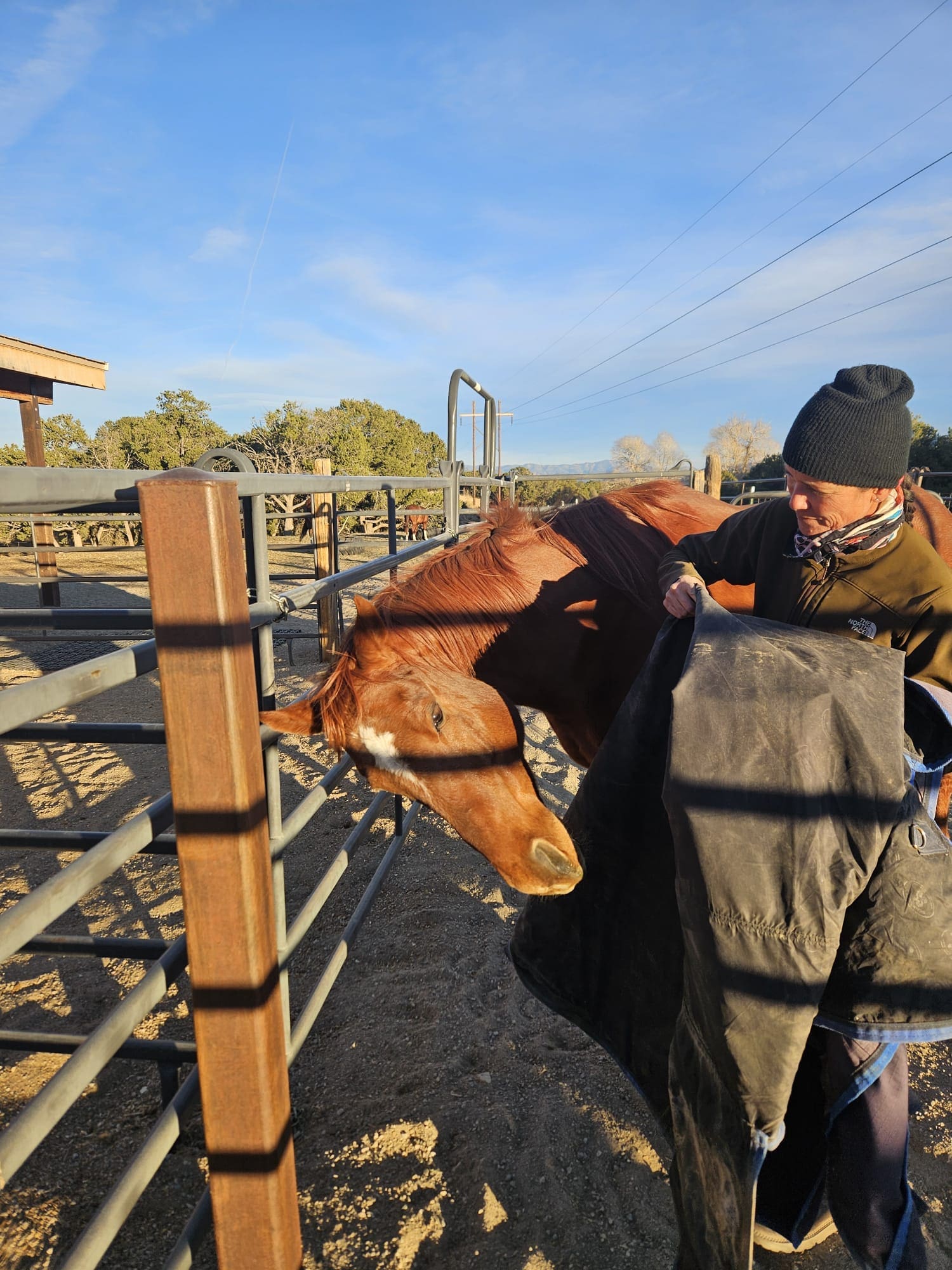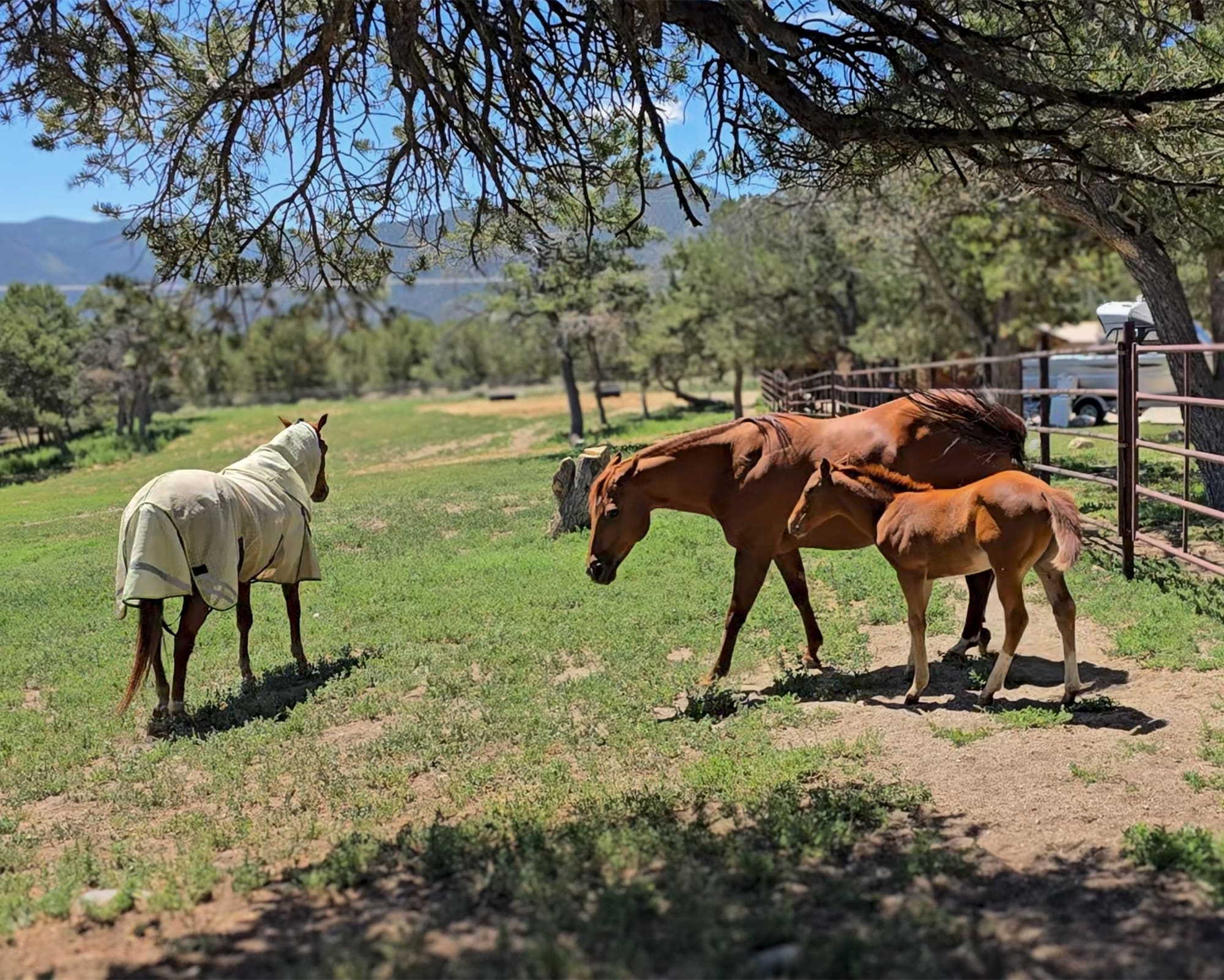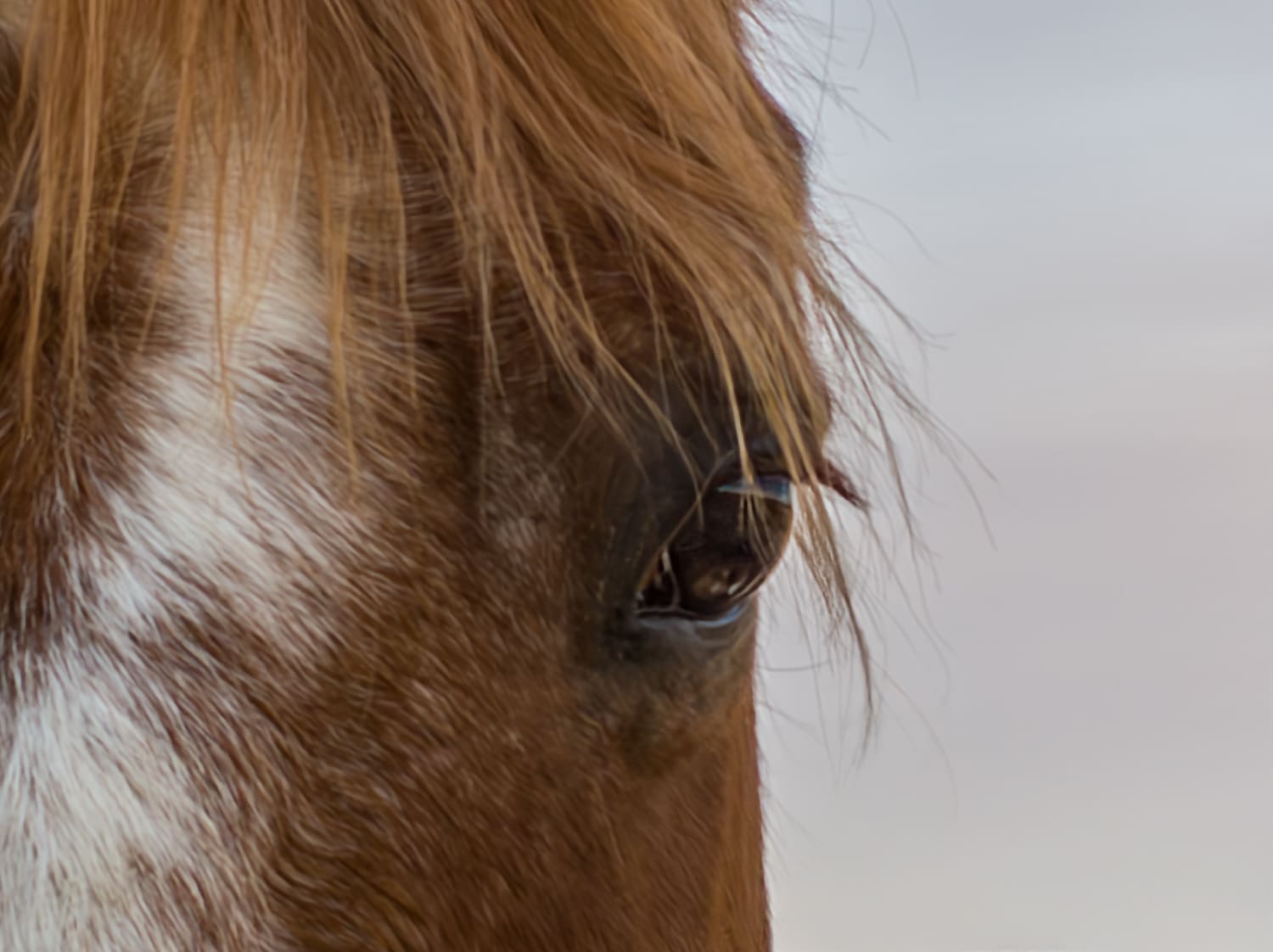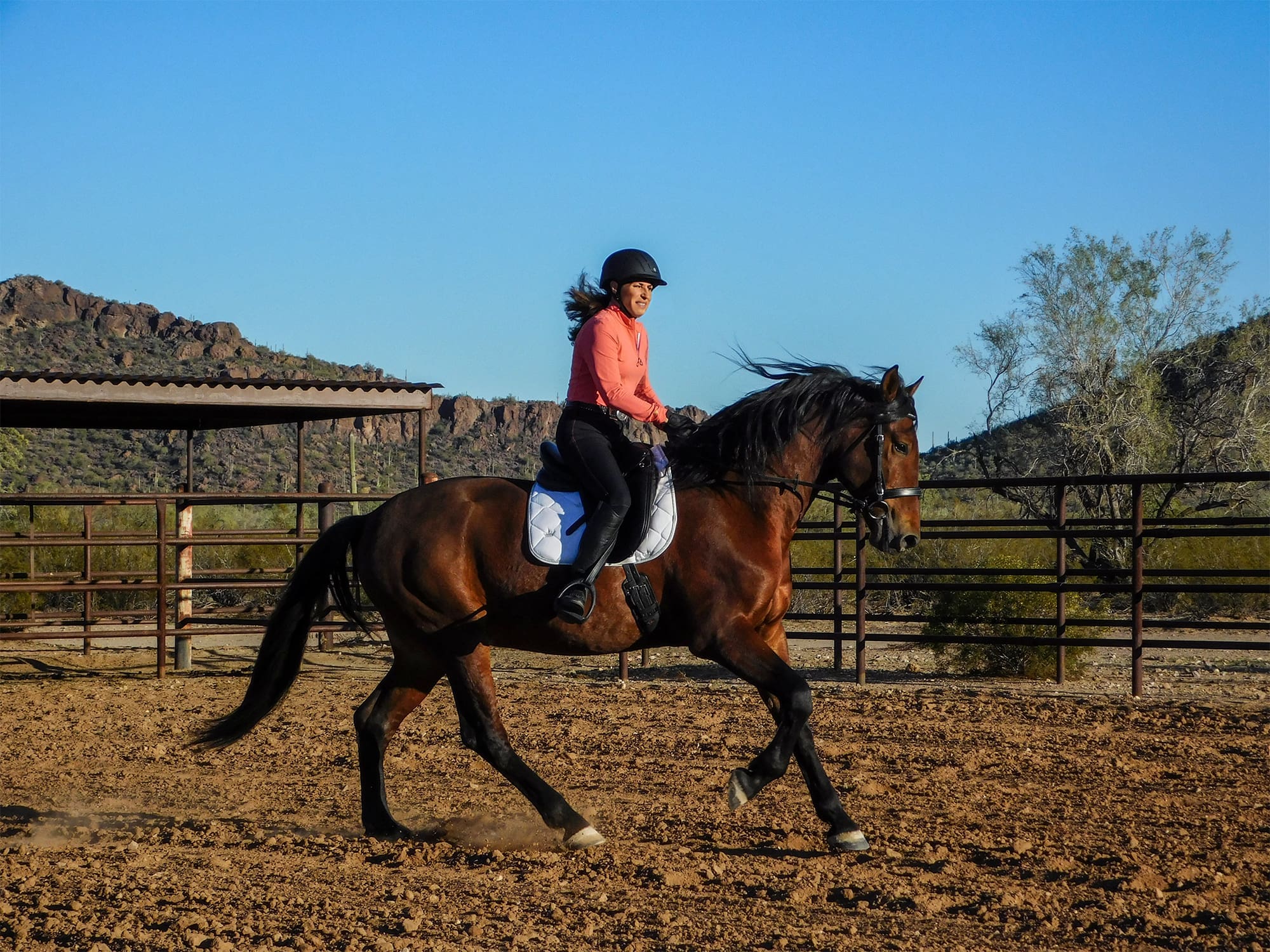It’s easy to lose confidence on the trail if your well-trained horse has defied you or refused to go forward. A threat to bolt or rear can make a confident rider worry and, in turn, contribute to the problem.
In that moment of refusal, you can choose to head for home or to step up and take charge.
If your well-trained trail horse suddenly throws a fit and refuses to ride out alone, chances are, you’ve allowed little acts of disobedience before this blow up.
It’s time to stop putting up with blatant acts of disrespect and confidently ride ahead.
“I’ve seen horses get away with little acts of disobedience and thus start to think they — and not the rider — are in charge,” says top trainer/clinician Julie Goodnight.
“Soon, instead of simply turning to look back toward where he wants to go, the horse escalates his threats. He might raise his front end as if to rear, or he may simply balk and refuse to keep moving down the trail.”
When a formerly well-trained horse starts with this type of behavior, Goodnight says riders often lose confidence and fear the worst will happen — that the horse will actually rear or turn and bolt.
If you turn for home, even just momentarily, instead of riding ahead, your horse learns just what to do to manipulate your emotions and “win” a chance to stop working.
“Your horse may just need a reminder that you, the rider, are in charge,” says Goodnight. “He may’ve been testing you, diminishing your confidence and manipulating your ride time. Stop the cycle by showing him you’re calmly in control.”
Here, Goodnight helps you observe your horse’s behavior patterns so that you can identify disobedience at its most subtle level and correct it before your horse has an all-out tantrum.
She’ll help you understand how the behavior escalated, how to fix your focus, and what to do to retrain your horse so he’ll move ahead willingly on the path you choose.
Goodnight will also explain to kids how to watch a horse’s ears to learn what he’s focused on.
Inside the Behavior
Understanding your horse’s motivation and behavior will boost your confidence and help you formulate a plan.
“Horses can threaten a lot of scary behaviors,” Goodnight says. “As much as we love them, horses can be willful and obstinately refuse to move forward. They’re master manipulators if they’ve learned that they can succeed with their antics of turning, stopping, threatening to rear, etc.
“If your horse can get you into an emotional state, he can learn that if he rears or threatens to rear you may turn for home — and he doesn’t have to work. To him, that means he has won points in a game called Let’s Go Home.”
When Goodnight was called in to help a horse-and-rider pair in Tucson, Arizona, she’d planned to observe what happened on the trail. However, she soon realized that the horse wasn’t even willing to leave the barn.
The rider, Liz, reported that she’d ridden her horse on the trail successfully in the past — he was a tried-and-true ranch horse. But lately, his tantrums kept Liz from riding out alone. He wouldn’t step forward; he’d turn his head and circle back to the barn.
“Liz had great riding position and was an experienced rider, but she’d allowed her horse to be disobedient without knowing it,” Goodnight says.
“Every time the horse turned his head to look back at his pen, Liz allowed him to turn in the direction he wanted to go before circling him back to the trail.
“While to Liz it seemed as though she was in control and pointed her horse where she wanted to go, her horse thought he ‘won’ with each step he got to take toward the barn.”
Goodnight explains how your horse keeps score of his steps and your ability to confidently direct his speed and direction.
“Say you want your horse to go right, toward the trail. He refuses, so you circle him around to the left. He has won. To him, his refusal paid off at the moment you turned him the way he wanted to go, to the left.”
In Liz’s case, she’d allowed the turn back to the barn too many times, so her horse thought he was in charge — each time she circled him, he ended up closer to the barn.
When Goodnight took the reins, the horse tried his antics only once. He quickly realized that he wasn’t going to get his way and walked obediently forward.
“This was a trained horse that had learned to test and threatened to throw a fit,” Goodnight says. “He’d learned that the game worked with Liz and that he would get his way when Liz would give up and go home.
“With me, he learned the game wouldn’t work and quickly was reminded of his training. It was time for Liz to break the cycle and teach her horse that his antics wouldn’t control her emotions and confidence any longer.”
If you’re observant, you can tell what a horse is thinking and feeling. Your horse is also very keen on your current emotional status.
Horses are quick to learn how to push your emotional buttons. They learn that when they get a tense, emotional response, they’ll get to turn home in just a few minutes.
Goodnight notes that horses are transparent in their communication. If your horse turns and looks toward the barn, that’s where he wants to go. If he’s whinnying, he’s calling out to find his friends, saying he wants to be back with the herd.
If your horse whinnies, you may be embarrassed, but it’s just horse behavior. It’s an expression of his emotion. He’s saying he feels alone, and he wants to be back with the herd. You can’t punish him for having that emotion, but you [ITAL]can[ITAL] correct the behaviors that follow that emotion.
Here’s how to regain your status as herd leader.
Step 1: Regain Your Confidence
How do you break the cycle and tell your horse that you’re in charge? The key is to put him into action and to make sure you know what to do in advance.
“As soon as Liz knew that she couldn’t allow her horse to turn toward his pen and the barn, she was on a new path,” Goodnight says. “With less than an hour’s practice, she was riding down the trail and away from the barn.”
Horses are great at detecting when your confidence lessens or your determination to move forward down the trail wanes, Goodnight explains.
“When you ride, your body is in close contact with your horse,” she says. “Your horse can feel when you’re tense and when you’re relaxed. If he begins to refuse or starts a temper tantrum, you may tense your body or simply shift your focus down onto him instead of where you want to go. He can feel the difference between when you look ahead. Your posture suggests you’re ready to move ahead on the trail. When you’re tense, you send the opposite message.”
Here’s the fix.
When you start to feel tense, keep looking ahead to where you want to go. Keep your eyes focused — not in a blank stare —and observe what’s in front of you on the trail.
Start to put your horse to work. Turn right, turn left (always turn away from the barn; never circle in the direction your horse wants to go), speed up, slow down, then turn right and left again.
Just changing your horse’s direction will give you more control and therefore more confidence. Any time you change direction, you remind him that you’re in control of where he can go. He’s not in control of the direction he goes.
Step 2. Break the Cycle
Both you and your horse need to make a big change if your horse is going to learn that you’re in charge and that he can no longer throw a fit to get his way.
How long this process will take will depend on how many points your horse has scored in the past. If he has a history of getting his way, it’ll be harder to correct your score.
The moment you step in the stirrup, let your horse know that you expect him to keep his nose in front of him and stand still. Basic obedience and control come first. As the rider, you control his direction and speed.
At first, work close to the barn in an area where you are more confident and feel at ease issuing a command. Chances are you’ll be more worried the farther you are from home. When you’re farther away, your horse will be thinking more about heading home, too.
To make a correction for turning his nose, pick up and bump with the opposite rein, using enough pressure to point his nose back toward the trail and dissuade him from doing it again.
If your horse turns his head toward the right, bump his head back to the left. Don’t allow him to turn to the right, and definitely don’t allow him to circle to the right to get back toward the trail.
If your horse looks back toward the barn (or his friends or the trailer) multiple times, put him to work.
When you ask him to change direction, stop, back up, trot circles one way then the other, etc. He then won’t have time to think about what’s behind him and will start to tune into your cues.
As you ride around the barn, always turn away from the barn each time you change direction. If you feel your horse’s focus shift to the barn and away from you, turn away from the barn and pick up the trot.
“If your horse throws a tantrum, he’ll soon learn that if he’s disobedient, you move him farther from the barn,” says Goodnight. “To expedite the training, I turn a horse toward the barn only when he’s calm and listening. I want to teach him that if he’s obedient and willing, he may get to go home and have a break.”
Gradually work your way farther from the barn. If you consistently insist on obedience, you should be able to work farther and farther away without having a big blow up. You horse will know that you’re now in charge.
Step 3: Get Back on the Trail
If your horse tries his antics on the trail, practice the same skills. Be sure to end your rides when you’re in charge and your horse’s training is on the upswing.
Horses are all different. If your horse has a short fuse or has had much success getting you to turn for home, it may be more of a challenge to ride out on the trail.
If your horse became more obedient when you worked him close to home, quickly changing his attitude, it may be time to push him when you’re farther from home.
If you have a problem away from home, dismount, and perform ground work with a rope halter and lead. Turn him left, turn him right, and make him move his feet.
Keep your horse’s motivation in mind, and don’t reward bad behavior. Even if you have to dismount, if you do that ground work, you’re ending on a good note. You’re letting him know he won’t get a break by pulling his usual antics.
Once you remind your horse that you’re in control, you may even be able to step back up in the stirrup and ride more.
Once your horse is compliant, you can head for home, knowing you’re not losing points.
But be careful — don’t throw in the towel and let your horse get everything he wants. You’re the herd leader. If you feel him (or yourself) getting tense, look confidently where you want to go, and remember that you have a plan.
Once you control your horse’s direction, you’ll boost your confidence and your horsemanship.F
For more on-the-trail skills every rider needs to know, check out my book, Goodnight’s Guide to Great Trail Riding, with free bonus DVD, It includes:
- Balance & Posture in Steep Terrain
- Safety: Emergency Brake, Stand Still for Mounting, & Reprogramming Spooky Behavior
- Training: Get Your Horse to Go the Speed you Ask—Every Time
- Jigging: Stop That Forever
- Sidepassing Skills
- Gate Opening & Closing
- Water Crossing
- Ground Tie
- Ponying
- Much More
Behavior Tip: Watch the Ears
Horses point their ears toward what they’re interested in and what they’re looking at. When you’re riding on the trail, watch your horse’s ears to tell whether he’s focused on the trail ahead and listening to you or thinking of heading home.
Practice paying attention to horses’ ears. Make it a game to find out what’s holding their attention. It may be a visiting deer or a horseback rider passing by.
Whenever you pass a field of horses, note what they’re paying attention to. This skill will transfer to your time in the saddle, helping you notice what your horse is paying attention to and thinking about.
When you ride, make sure your horse is looking straight ahead on the path you’ve chosen.



